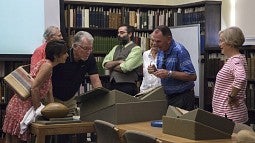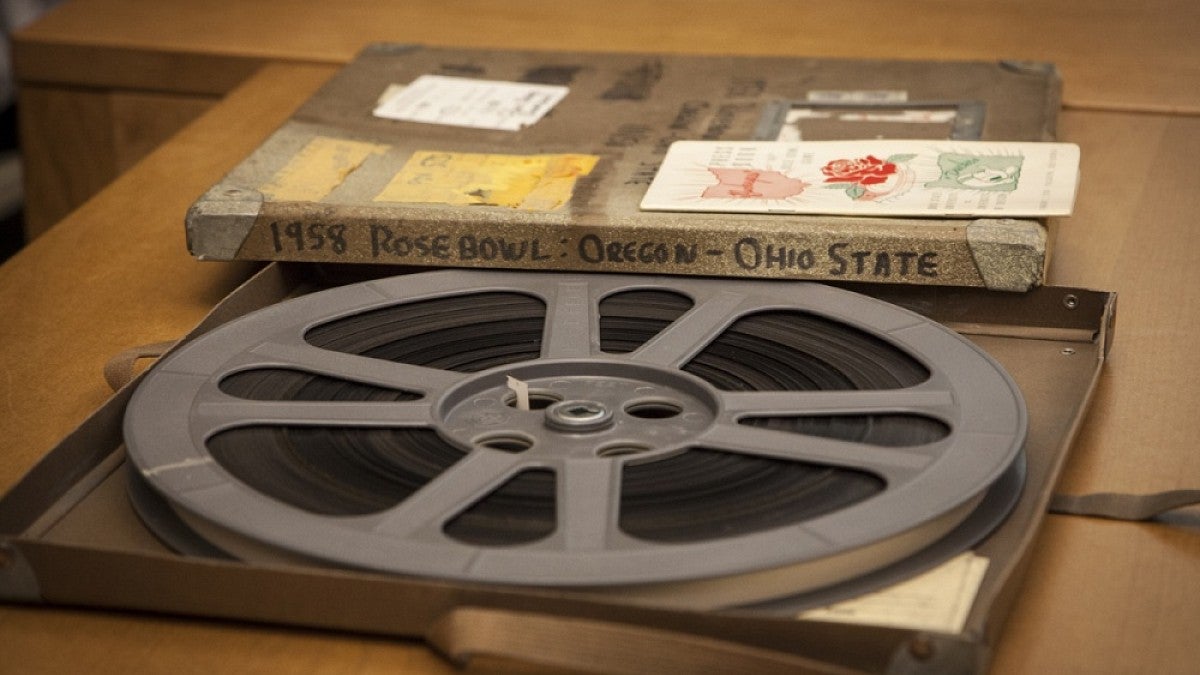When the UO’s two winningest football coaches ever met at the Knight Library recently for a little blast from the past, they were reminded that recollections sometimes clash with reality.
“When you see yourself on film, it’s like they say: The eye in the sky does not lie,” former coach Mike Bellotti said to his sidelines predecessor, Rich Brooks.

Accompanied by their spouses, Colleen Bellotti and Karen Brooks, the two coaches recently visited Special Collections and University Archives in Knight Library for a special viewing of historic athletics films, memorabilia and records. Joining them were longtime friends and athletics and UO Libraries supporters Ken Singer, who was the Ducks’ team orthopedist for 35 years; his wife Kenda; and Walt and Gretchen Barger. Walt Barger has served on the UO Libraries Advancement Council for 11 years.
It was a trip down memory lane for Brooks, who led the Ducks from 1977 to 1994, and Bellotti, who succeeded Brooks in 1995 and walked the Autzen Stadium sidelines until 2008. Together they racked up more Duck wins than any other gridiron coaches. What’s more, both men are library donors.
“There are a variety of materials in the archives pertaining to their respective tenures as coaches,” said Jennifer O’Neal, the Corrigan-Solari University Historian and Archivist with UO Libraries. “Beyond just reviewing their own time at the university, we wanted to provide them with a comprehensive presentation that would reflect the entire history of Oregon athletics.”
To that end, O’Neal and her colleagues in Special Collections and University Archives pulled together a selection of letters, documents, ephemera and films with the oldest materials dating back more than a century.
“Libraries to me are the bastion of the preservation of history,” said Bellotti, a member of the library’s Advancement Council. “Today we saw the history of the football program at the University of Oregon.”
Of course, the history of Ducks football is history that the two coaches helped make. In particular, one archival medium came to the forefront in its ability to rekindle their memories and insights: the medium of film. Brooks and Bellotti not only appeared onscreen but also at times turned out to be the films’ creators.
“Coaches’ film is what you use to break down your team’s tendencies on offense, defense and in the kicking game,” Brooks said. “You also use it to study your opponents. When we got a copy of the game films, we would cut and splice all the first, second and third downs together, in order to study tendencies by down and distance. Each coach would splice together their own training reel to teach players.”
“The development of film as a coach’s tool was from the aspect of teaching,” Bellotti said. “Every coach had a hot-splicing machine in his office. With all that cutting and splicing, and all the times we ran it back and forth through the projectors, it is amazing that some of this film is still in fairly watchable condition.”
That feeling is echoed by Lauren Goss, a UO Libraries Thomas intern who is working on a project to inspect and begin preserving the Department of Intercollegiate Athletics film collection.
“Unfortunately, film is an endangered medium and is subject to rapid and severe deterioration,” Goss said. “For example, a film from the 1950s showing the UO football team playing at USC will require expert consultation due to its serious fragility and potentially irreparable damage. Only robust preservation measures can stem the tide of further deterioration, and comprehensive digitization will be required for increased access.”
In addition to the spliced-together coaches’ film, the library screened intact footage from a number of historic Ducks games. The coaches seemed to particularly enjoy watching film of the 1948 Cotton Bowl team coached by Jim Aiken and led by Norm Van Brocklin.
On the other hand, viewing games they had coached stirred up a mix of emotions. Quipped Bellotti: “All my bowl game victories, I want to watch all those again. My bowl game losses, not so much.”
For Brooks, one of the films revealed a long-forgotten, personal moment.
“We looked at our 1979 game at Colorado, when we beat Chuck Fairbanks,” he said. “There was a newsreel clip of me coming out of the locker room and hugging my wife Karen. We had never seen that before. It was nice.”
While they could not help but bring a touch of personal nostalgia to their viewing, the coaches were quick to acknowledge that researchers would approach the material from a variety of angles.
Said Brooks, “With all the exposure that the UO gets today, I know they get lots of media requests for old footage. So it’s great to have all the great and even the not-so-great moments on film. These are unique views of the games, different than the TV broadcasts. So the fans can look back and remember fondly, but researchers will go back and compare.”
“You can watch not only the evolution of the game, but the evolution of the players — their size, strength and speed,” Bellotti added. “We sometimes talk about a player who was ‘ahead of his time.’ With archived film, researchers can go back and see for themselves instead of just relying on word of mouth.”
Zach Bigalke, a graduate student in the department of history and archive research assistant with the UO Libraries, has worked to consolidate and catalog the intercollegiate athletics collections.
“I have come across many hidden gems that have helped inform my own research as well as enriching the work of other scholars,” he said. “As a sport historian in training, I have been able to see both the academic and public research value of these collections, and have assisted scholars from other universities as well as journalists from local and national media outlets.”
In order to ensure that future students and researchers will enjoy the same access to the archived materials, the UO Libraries is engaged in an ongoing effort to raise funds for their restoration, cataloging and long-term preservation. O’Neal projects that costs will total $40,000 for the paper records and memorabilia.
Assisted by Goss, Curator of Moving Images Elizabeth Peterson has estimated that the cost for the films will be approximately $1.5 million. “While the amount is significant, it is not excessive in light of the historic value of these materials,” she said.
“I think it is imperative that there is restoration of these archives, so people will be able to research the players, coaches and teams,” Brooks said. “It will be very valuable for generations to come to be able see where UO athletics came from and how it got to where it is today.”
—By Jason Stone, UO Libraries


